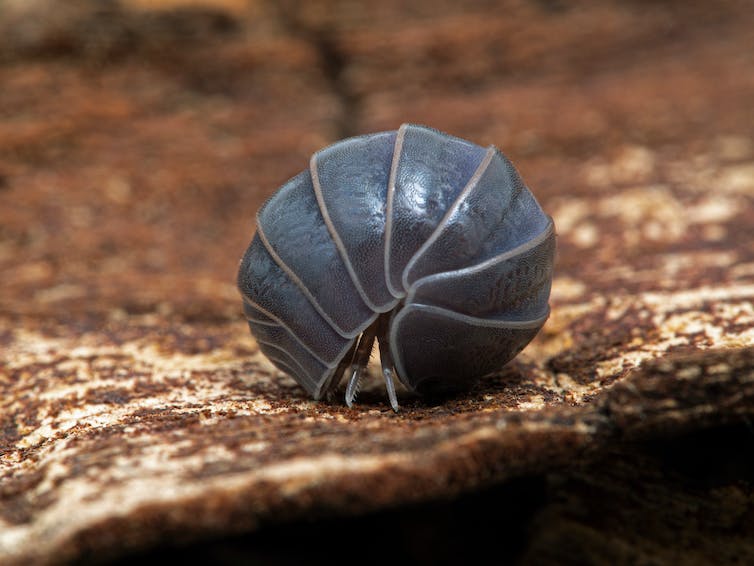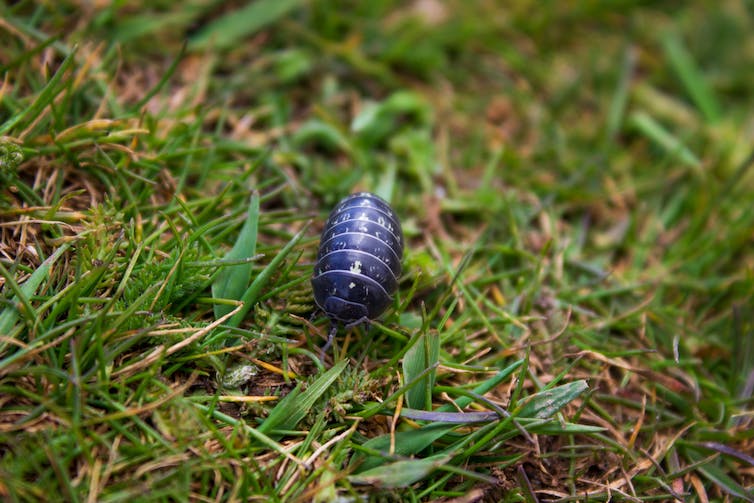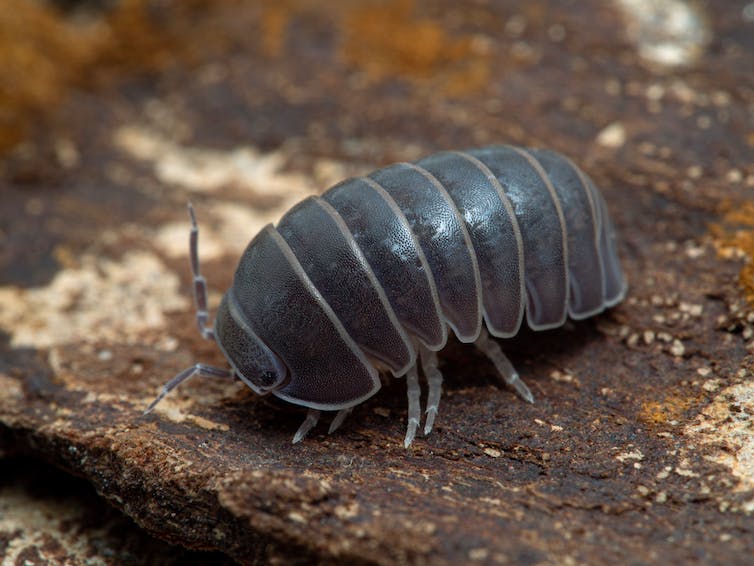![]()
Lots of adults dislike woodlice. Some are physically revolted by them. But this distaste is cultural rather than innate since most small children are well-disposed towards woodlice and happy to handle them. Some people even keep them as pets.
Woodlice are tiny, don’t bite, move slowly and are generally unthreatening. They are part of biological processes essential to life. So what’s not to like?
Part of the problem is their name. There are dozens of unflattering English names for woodlice that imply completely imaginary parasitic habits (“lice”), while others (“sow-bug”) link them with dirty lifestyles. But woodlice are harmless. As it happens, they do excrete ammonia and smell bad if you confine a crowd of them in a jam jar, but who does that?
It’s also true that inside our homes, these little invertebrates are strongly associated with damp and fungal decay. But while many pest control firms offer elimination treatments, woodlice are the symptom not the cause. They chew up soft, damp, mouldy bits of wood – but your floorboards or window frames would already need to be in a bad way for this to happen.
As many schoolchildren have shown in classroom experiments, woodlice simply avoid the light, seek out moist air, and prefer places that smell of mould. So save your money. Unless you fix the underlying structural problem, they’ll be back.

Worldwide there are around 4,000 species of woodlice, with 40 species in the UK alone. They mostly look alike and are similar in size (adults are 10-15mm long). These familiar invertebrates are crustaceans, related to crabs, shrimps and lobsters. Woodlice ancestors were probably among the earliest animals to invade the land almost half a billion years ago. They live in rotting wood and soil and are abundant – one study reported densities of up to 3,000 woodlice per square metre of grassland.
A bad press
Why don’t people think of woodlice as nice? Perhaps it’s because they look like little armoured aliens from Star Trek. Sporting seven pairs of legs, their bodies are encased in armoured plates so full of minerals containing calcium that only specialised predators can attack them successfully. These tiny creatures just bumble around in their own world, ignoring human observers.

Antagonism towards woodlice is misplaced. They are our friends. In fact we (along with all the rest of land-based animal and plant life) would be in trouble without them. Woodlice are detritivores that eat dead plants and animals, as well as everyone’s excrement including their own.
By recycling waste, woodlice and other tiny soil animals keep the wheels of the biosphere’s economy turning. All plants and animals must eventually be broken down and recycled or there would soon be no fertile soil in which plants could grow. Woodlice start this process by chewing up detritus.
Other similar-sized soil animals such as millipedes also do this job but are less abundant. Woodlice aren’t the most numerous of soil animals – roundworms, springtails (minuscule wingless, jumping insects) and mites all live in greater numbers – but because they are individually much bigger, woodlice can process a lot more litter overall. Once they have digested waste material and excreted it again, microorganisms continue the breakdown of this organic material.
Woodlice are a bit like us
Perhaps we should be more generous to woodlice because in some ways they are like us. They are, for example, one of the few invertebrates that bear live young. This is necessary because their body surfaces aren’t well waterproofed and are restricted to moist places.
While older woodlice can avoid dehydration by moving to a more suitable place, hatchlings can’t do this. So female woodlice lay their fertilised eggs into a fluid-filled brood pouch between their legs. Inside this pouch they can develop in a safe place and are protected from drying out.
The vast majority of animals don’t have offspring that develop to an advanced stage inside their mother, as it is costly to her and restricts the number of offspring. But some crustaceans that live in the sea – including the probable ancestors of woodlice – protect their developing eggs within a brood pouch because it allows them to choose the location in which to deposit their offspring. This adaptation made it easier for woodlice to make the evolutionary transition to life on land.

Woodlice are also models for flexible sex determination. Unlike all other invertebrates, the sexual development of both their reproductive anatomy and behavioural circuits in the brain are regulated by a sex-determining hormone, which causes young woodlice in the pouch to develop as males. Without it, they will become female.
Testosterone and other steroid hormones play a similar role during the foetal development of humans and other mammals. But this is very unusual among invertebrates, in almost all of which sex is determined directly by
their genes.
Woodlice’s hormonal sex determination mechanism has, however, been hijacked by some strains of the bacterium Wolbachia. This is a parasite transmitted from mother to offspring in many woodlouse species. The bacterium interferes with normal hormonal sex determination, so genetically male woodlice embryos develop as functional females, which favours the parasite’s spread.
As a result, sex ratios in infected woodlouse populations are heavily biased towards females (up to 10:1). The population growth of the parasite is probably limited by the fact that it makes it difficult for female woodlice to find mates, but also because Wolbachia infection also reduces host fertility. Who would have thought the sex lives of woodlice could be so complicated?![]()
Stuart Reynolds, Emeritus Professor of Biology, University of Bath
This article is republished from The Conversation under a Creative Commons license. Read the original article.
Source Link: In Defence Of Woodlice And Their Complicated Sex Lives